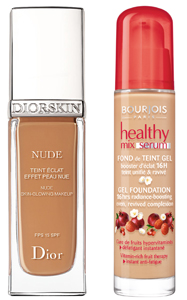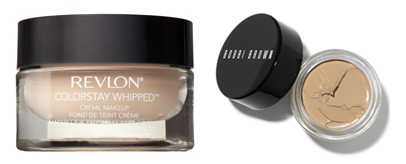There are four basic formulations to choose from: powder, liquid, crème, and stick foundation (I could have included ‘mousse’ in here but I didn’t, because it’s crap). You need to consider the following when deciding which is best for you:
- Most importantly, what is your skin type? This is essential – is your skin oily, dry, combination, or sensitive? You don’t need to pick just one option – I have an oily t-zone, dry cheeks and my skin is incredibly sensitive.
- What level of coverage do you need?
- Which texture do you prefer (ie matte, dewy, luminous, velvety)?
- You should consider not only the colour of the skin on your face, but also the colour of your neck and décolletage –your foundation should blend seamlessly into these areas (by this I don’t mean putting the product on your neck and chest, I mean that the colour of the skin in these areas should be as uniform as possible).
Your options
Powder foundation
This feels light on the skin and buffs to a soft, velvety finish. It normally contains minerals, so is very good choice if you prefer natural products
Best for: Oily skins that have a tendency to break out.
Save: Bourjois Healthy Mix Powder Foundation (available at Edgars Red Square)
Splurge: MAC Mineralize Skinfinish Natural
Liquid foundation
This is the most generic formulation. It is fairly hydrating and offers medium to full coverage. This is my preferred formulation – almost all of my foundations are liquid foundations.
Best for: Combination to dry skin
Save: Bourjois Healthy Mix Gel Serum Foundation
Splurge: Dior Diorskin Nude Skin-Glowing Makeup SPF 15
Crème foundation
This formulation is rich and creamy. It gives full, long-lasting coverage, and is very hydrating.
Best for: Dry or mature skin. If you want to use a crème foundation and your skin is slightly oilier, just make sure that you set it with some powder and you should be good to go!
Save: Revlon Colorstay Whipped Crème Makeup
Splurge: Bobbi Brown EXTRA Repair Foundation SPF 25
Stick foundation
Provides heavier coverage, which is not so daylight friendly, but is good for blemished skin and evening use.
Best for: Blemished skin. Those with oily skins should avoid stick foundations as they can be very creamy.
Save: Max Factor Pan Stick Foundation
Splurge: Bobbi Brown Foundation Stick
Application
I like to apply my foundation using a domed blending brush and gently buff it into my skin – but that’s just a personal preference. You can use your hands, sponges, flat brushes, whatever works best for you. I will however say that if you are using a liquid foundation, a sponge will absorb a lot of product – best to use brushes or fingers here (I will be doing a separate post about which brushes work best with which formulation).
Top tip: My grandmother gave me a lot of sage advice (such as: never trust a man whose eyes are too close together, and never tell a good looking man that he is good looking – it’s not good for his ego), and she always emphasized the importance of applying foundation in the most natural light possible. If I can impart any wisdom to you, it would be this: please do not apply your foundation in room filled with artificial light – it can leave you with the most unpleasant and unnatural finish. Rather be faced with your naked face in the harsh light of day and do a proper job – it can be brutal, I know, but trust me when I tell you, it’s the only way.
Lastly, please remember that you don’t need to apply foundation onto your entire face – you can focus it only on those areas that need it. And you also want to keep it as thin as possible around the edges of the face – otherwise you can end up looking like you’re wearing a mask.
I hope that was helpful – it you have any questions, suggestions of comments, please do let me know.





